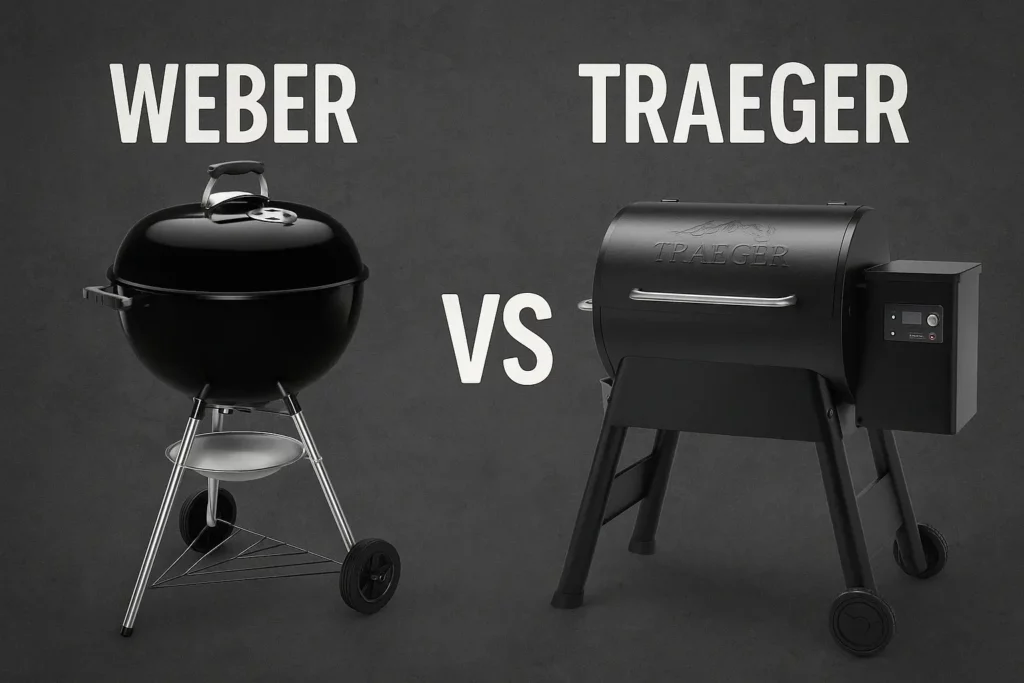This post may contain affiliate links. If you use these links to buy something we may earn a small commission. Thanks.
When it comes to outdoor cooking, few rivalries spark as much debate as Weber vs Traeger. Whether you’re a die-hard charcoal lover, a fan of gas efficiency, or someone obsessed with wood-fired flavor, choosing the right grill brand can significantly elevate your backyard BBQ game.
Both Weber and Traeger have carved out loyal fan bases over the decades, but they cater to distinctly different grilling styles. In this in-depth comparison, we’ll explore their brand histories, products, technology, cooking performance, and more—so you can confidently decide which grill suits your lifestyle.
1. Weber – The Icon of Backyard Grilling
- Holds up to 13 burgers made with a Weber burger press
- One-Touch cleaning system provides hassle-free ash cleanup
- Porcelain-enameled lid and bowl Retain heat, and won’t rust or peel
Founded in 1952 by George Stephen, Weber revolutionized backyard cooking with the invention of the dome-shaped charcoal kettle grill. What started as a cut-up marine buoy has evolved into a global BBQ empire.
Weber is known for:
- A wide range of gas, charcoal, and electric grills
- Innovations like the Flavorizer Bar system
- Durable build quality and iconic designs
- Consistent upgrades to smart technology (like Weber Connect)
The brand’s longevity speaks volumes it’s a household name trusted by seasoned grillers and beginners alike.
2. Traeger – The Wood-Fired Innovator
- Smart Grilling Control: WiFIRE technology lets you monitor and control the smoker from anywhere...
- Wood-Fired Flavor: This wood pellet smoker grill uses all-natural hardwood pellets and Super Smoke...
- Versatile 6-in-1 Cooking: Grill, smoke, bake, roast, braise, and BBQ on one electric pellet smoker....
Traeger entered the scene in 1985, founded by Joe Traeger, who patented the first wood pellet grill. This introduced a completely new style of outdoor cooking one that emphasized slow smoking, rich flavor, and convenience.
Traeger is known for:
- Pioneering pellet grill technology
- Consistent wood-smoked flavor
- Smart grilling innovations like WiFIRE® Technology
- An ecosystem of accessories, apps, and wood pellets
While newer than Weber, Traeger’s rise has been meteoric among barbecue purists and tech-savvy cooks.

Comparison table for Weber vs Traeger:
| Feature | Weber | Traeger |
|---|
| Founded | 1952 | 1985 |
| Primary Fuel Types | Gas, Charcoal, Electric | Wood Pellets |
| Grill Types | Gas grills, charcoal grills, electric grills, smart grills | Pellet grills only |
| Temperature Range | Up to 600°F+ | 180°F to 500°F |
| Best For | High-heat searing, versatile grilling | Low-and-slow smoking, wood-fired flavor |
| Smart Technology | Weber Connect (select models) | WiFIRE (standard on most models) |
| Ease of Use | Moderate (gas easy, charcoal harder) | Very easy, set-it-and-forget-it grilling |
| Flavor Profile | Classic grilled flavor | Rich, smoky, wood-fired taste |
| Heat Control | Manual (vents/knobs), good precision | Automated digital controls with precise temperature |
| Startup Time | Fast (gas), moderate (charcoal) | Moderate (5–15 min to heat up pellets) |
| Portability | Wide range, including compact options | Less portable due to size and power needs |
| Build Quality | Durable, stainless steel & porcelain enamel | Sturdy, powder-coated steel |
| Maintenance | Low (especially gas); some ash with charcoal | Moderate (ash cleanout, grease trap, pellet hopper refill) |
| Entry-Level Pricing | ~$120 (charcoal) | ~$500 (Pro Series) |
| Premium Pricing | $2,000+ (Summit Series) | $2,000+ (Timberline Series) |
| Best For Beginners | Gas models | All models |
| Customization | Extensive (griddles, sear kits, rotisseries, side burners) | Moderate (shelves, sear plates, pellet types) |
| Warranty | 5–10 years depending on model | 3–10 years depending on model |
Grill Types Offered
2.1 Weber’s Grill Lineup
Weber offers a wide selection of grills that cater to different cooking styles:
- Gas Grills: The Spirit, Genesis, and Summit series are beloved for fast, even cooking. Genesis models feature high heat output and premium construction.
- Charcoal Grills: From the classic Original Kettle to the Performer Deluxe, these grills appeal to traditionalists who love searing and smoky flavor.
- Electric Grills: Compact models like the Weber Q 1400 suit apartment dwellers or those with limited outdoor space.
- Smart Grills: The Weber Smart Grill Hub and Wi-Fi connected options bring technology into traditional formats.
This diversity makes Weber incredibly versatile for all levels of grillers.
2.2 Traeger’s Grill Lineup
Traeger focuses exclusively on wood pellet grills, excelling in one category rather than branching into multiple:
- Pro Series: Entry-level models like the Pro 575 and 780 are excellent for backyard smoking and grilling.
- Ironwood Series: These mid-tier grills offer better insulation, dual-position grates, and D2 Direct Drive systems.
- Timberline Series: High-end models with superior insulation, built-in meat probes, touchscreen controls, and more.
All Traeger grills run on wood pellets and offer WiFIRE® smart control, making low-and-slow cooking almost effortless.
Cooking Performance
When comparing Weber and Traeger, cooking performance is where philosophies diverge.
Weber: High Heat, Versatility, and Direct Cooking
Weber grills excel at direct-heat cooking, making them ideal for searing steaks, grilling burgers, and quick meals. Charcoal models offer classic smoky flavor, while gas grills heat up in minutes and provide consistent control.
Performance Highlights:
- Heats up quickly (especially gas models)
- Can reach 600°F+ for high-heat searing
- Easier to adjust for dual-zone cooking
- Works well for direct and indirect cooking
Traeger: Low and Slow, Smoky Precision
Traeger shines in indirect cooking and slow smoking. Their pellet system feeds wood into a fire pot automatically, maintaining consistent temperatures.
Performance Highlights:
- Precise temperature control (180°F–500°F)
- Infuses rich, wood-fired flavor into meats
- Excellent for brisket, ribs, pork shoulder
- Not ideal for ultra-high searing (unless using accessories like the Traeger Sear Plate)
In summary, Weber is your go-to for high heat and quick cooking, while Traeger is perfect for slow-smoked BBQ with bold flavor.
Technology & Smart Features
Weber Connect
Weber’s smart grilling system integrates with a mobile app to offer:
- Real-time temperature monitoring
- Cooking countdowns
- Food probes and step-by-step guides
- Available on premium models or as an add-on (Weber Connect Smart Grilling Hub)
Traeger WiFIRE
Traeger’s WiFIRE® platform sets the gold standard for smart grilling:
- Control grill temperature remotely via app
- Adjust timers, set meat probe alerts
- Connects to Traeger App for over 1,500 recipes
- Compatible with voice control (Alexa)
Overall, Traeger edges out Weber in this category due to its seamless integration and fully connected experience from start to finish.
Build Quality & Design
Weber
- Material: Stainless steel, porcelain-enameled lids, cast iron grates
- Design: Sleek, utilitarian, iconic dome-style for charcoal grills
- Durability: Built to last 10+ years with proper care
- Ease of Maintenance: Grease traps and ash catchers make cleanup manageable
Traeger
- Material: Powder-coated steel, porcelain-coated grates
- Design: Barrel shape with side hopper for pellets
- Durability: Good insulation and weather resistance
- Ease of Maintenance: Pellet ash and grease require regular emptying
Both brands are well-constructed, but Weber’s stainless steel upgrades and cast-iron options often feel a bit more premium.
Ease of Use
Weber
- Startup: Gas ignites instantly; charcoal takes longer
- Control: Manual knobs or vents
- Refueling: Propane tanks or adding charcoal mid-cook
- Learning Curve: Low for gas grills, moderate for charcoal
Traeger
- Startup: One-button ignition
- Control: Digital temperature control
- Refueling: Add pellets to hopper
- Learning Curve: Very beginner-friendly
Traeger is ideal for set-it-and-forget-it cooks. Weber provides a more hands-on experience, which some grillers love.
Accessories & Customization
Weber Accessories
- Rotisserie kits
- Sear stations
- Side burners
- Weber Crafted cooking system (pizza stones, woks, griddles)
- Griddle inserts for breakfast or flat-top cooking
Traeger Accessories
- Front shelves
- Pellet storage bins
- Sear plates and griddles
- Cast iron cookware
- Signature wood pellet blends
Both offer extensive customization, though Weber leans more toward grilling versatility, while Traeger stays focused on enhancing the pellet smoking experience.
Pricing & Value for Money
Weber Pricing
- Entry-level: ~$120 (charcoal)
- Mid-range: $400–$1,200 (gas)
- Premium: $2,000+ (Summit Series)
Traeger Pricing
- Entry-level: ~$500 (Pro Series)
- Mid-range: $800–$1,600 (Ironwood Series)
- Premium: $2,000+ (Timberline Series)
Value Comparison:
- Weber offers more variety at lower price points
- Traeger provides a streamlined, tech-rich experience
- Pellet cost over time can add up for Traeger users
Weber gives better value for traditional grilling, while Traeger is ideal if you’re investing in premium wood-fired cooking.
Best For Whom?
Choose Weber If:
- You love classic BBQ styles (gas, charcoal, or electric)
- You want quick grilling and high-heat searing
- You prefer a variety of cooking methods
- You’re on a tighter budget
Choose Traeger If:
- You want to master smoked brisket, ribs, and roasts
- You prefer set-it-and-forget-it automation
- You enjoy smart tech integration and recipe apps
- You’re willing to invest in pellet refills
Pros and Cons
Weber Pros:
- Multiple fuel options (gas, charcoal, electric)
- Broad price range and model variety
- High heat capability for searing
- Reliable and built to last
Weber Cons:
- Limited smart features in lower-tier models
- Charcoal and propane require manual monitoring
Traeger Pros:
- Rich, consistent smoke flavor
- User-friendly WiFIRE technology
- Temperature precision and ease of use
- Built-in meat probes and automated controls
Traeger Cons:
- Higher starting price
- Doesn’t sear as well as gas/charcoal without add-ons
- Relies entirely on pellets, which can add ongoing cost
Final Verdict
If you’re a BBQ purist who loves hands-on cooking, high-heat searing, or the nostalgic crackle of charcoal, Weber will satisfy your grilling cravings. It’s budget-friendly, versatile, and time-tested.
If you’re passionate about smoked meats, low-and-slow BBQ, and smart tech that lets you walk away while your brisket smokes to perfection, Traeger is your perfect partner.
Ultimately, there’s no “better” brand just the one that matches your grilling style.
FAQs
Q1: Can you smoke meat on a Weber grill?
Yes. Weber charcoal grills and some gas models support indirect cooking with wood chips or smoker boxes, though they don’t match the precision of Traeger pellet grills.
Q2: Does Traeger cook as fast as gas grills?
No. Traeger focuses on low-and-slow smoking, though it can grill at 450–500°F. It won’t match Weber’s searing speed.
Q3: Are Weber or Traeger grills better for beginners?
Traeger wins for beginners due to its digital controls and automation. Weber gas grills are also easy to learn.
Q4: Which grill is easier to maintain?
Weber gas grills are easier overall. Traegers require periodic cleaning of ash and grease buildup, plus consistent pellet refills.
Q5: Can you use Traeger pellets in other pellet grills?
Yes. Traeger pellets are compatible with most other pellet grill brands, though some companies recommend using their own pellets for warranty purposes.


